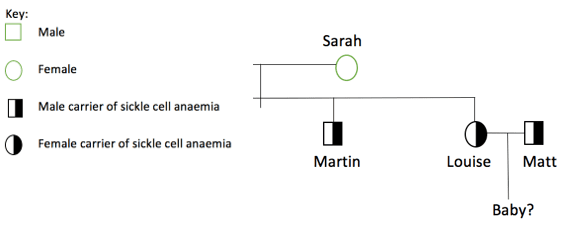In this post
The study of monohybrid inheritance involves examining the inheritance of a single characteristic based on the combination of the alleles inherited from the mother and father. Genetic diagrams can be used to describe patterns of monohybrid inheritance such as the inheritance of eye colour. To produce a genetic diagram and determine the potential genotypes of the offspring produced, the phenotypes and genotypes for both parents must be known.
Worked example
As the allele for blue eyes is recessive, a mother with blue eyes can only have the genotype bb. As the allele for brown eyes is dominant, a father with brown eyes could have either the genotype BB or Bb. The genetic diagram for the genotype of the father being Bb is shown below:

Monohybrid crosses can also be used to predict the probabilities of outcomes for inherited characteristics from possible phenotypes of offspring produced from a combination of the father’s and mother’s alleles.
The following worked example outlines how a monohybrid cross can be used to determine the probability of a baby with blue eyes being born to a mother with blue eyes and a father with brown eyes.
| Mother | |||
| Gametes | b | b | |
| Father | B | Bb | Bb |
| b | bb | bb | |
If the father’s genotype was Bb, two out of four of the offspring would have the genotype Bb and the phenotype brown eyes and two out of four would have the genotype bb and the phenotype blue eyes.
Therefore, the probability of the offspring having blue eyes would be two out of four or 50%.
However, if the father’s genotype was BB, the probability of the offspring having the phenotype blue eyes would be different as the following genetic diagram shows:
| Mother | |||
| Gametes | b | b | |
| Father | B | Bb | Bb |
| B | Bb | Bb | |
In this scenario all the offspring inherit the genotype Bb and would therefore have the phenotype brown eyes.
There is 0% chance of any offspring having blue eyes from this combination of alleles.
Family pedigrees
Genetic diagrams and monohybrid crosses are useful to predict the inheritance of alleles through one generation. Family pedigree diagrams, or pedigree analysis, can be used to show how alleles are passed on through several generations in a family and make predictions about the possible outcomes for future generations. Pedigree analysis can also be used to determine whether characteristics are controlled by recessive or dominant alleles.
Sickle cell anaemia is an inherited disease carried by a recessive allele. This means that sufferers must have two copies of the allele. If only one copy of the allele is present the person will not suffer from the condition but is known as a carrier and could pass this allele on to future generations if they have a child with someone else who is a carrier. A carrier is someone who carries the allele for the disease but does not themselves suffer from it. In a pedigree analysis the 1st generation parents are placed at the top. A key is used with shapes and shading used to distinguish between the sexes and phenotypes of each family member.
In most family diagrams, squares are used to represent males and circles used to represent females. The shaded circles and squares usually represent those family members who do have the disease and half shaded shapes represent those family members who are carriers of the disease. White squares and circles represent people who do not carry the allele or have the disease and are termed normal.
An example of a pedigree diagram for sickle cell anaemia inheritance is shown in the following diagram:

Mike is a male carrier of sickle cell anaemia whereas Sarah does not have the allele. Mike and Sarah had four children – Robert, Rachel, Martin and Louise. Robert and Rachel do not suffer from sickle cell anaemia and are not carriers, but Martin and Louise are both carriers of the disease.
The pedigree analysis shows that the allele for sickle cell anaemia is not dominant because the family members carry the allele but do not suffer from the disease. If the allele was dominant, then all the children born to Mike and Sarah would be carriers of the disease and would therefore suffer from the disease.
Louise then has a baby with Matt, who is also a carrier of the disease. If Louise and Matt are both carriers, and the allele for sickle cell anaemia is recessive, their genotype must be heterozygous as Ss. The probability of the new baby having sickle cell anaemia can be determined using a genetic diagram as follows:

As the genetic diagram shows, there is a one in four (25%) chance that the baby will be born with the ss phenotype and will suffer from sickle cell anaemia. There is also a one in four (25%) chance that the baby will be born with the SS phenotype meaning that they will neither suffer from, nor be a carrier of, the disease.
There is a two in four (50%) chance that the baby will be born with the phenotype Ss and will therefore be a carrier of the disease.
Sex determination
The sex of a person is controlled by the 23rd pair of chromosomes in the nucleus. The chromosomes in this 23rd pair are either X or Y chromosomes. All egg cells have one X chromosome, but sperm cells can have either an X or a Y chromosome. Therefore, the determination of sex in humans depends upon whether the sperm cell which fertilises the egg contains an X or a Y chromosome. If the sperm cell has an X chromosome, the fertilised egg cell produced will have a genotype of XX and female characteristics will develop in the organism.
If the sperm cell has a Y chromosome, the fertilised egg cell produced will have a genotype of XY and male characteristics will develop in the organism. The sex of offspring at fertilisation can be determined using a genetic diagram as shown below:

As the genetic diagram above shows, two out of four offspring have the XX chromosome combination and would therefore be female. The other two out of four offspring would have the XY chromosome combination and would therefore be male. Every time any sperm cell fertilises an egg cell there is always an equal probability that each offspring will be either a boy or a girl.
Codominance
Sometimes neither of the alleles in a pair are dominant or recessive and so both alleles will influence the phenotype for that characteristic. This is known as codominance.
Codominance of alleles results in the observation of more than two possible phenotypes for that characteristic. A good example of codominance in action is the inheritance of blood groups in humans.
Blood groups in humans is determined by three different alleles which are IA, IB and IO. The letter I stands for immunoglobulin and the letter following determines the blood type of the person. IA is for blood type A, IB is for blood type B and IO is for blood type O.
The IO allele is recessive. For a person to have the IO gene and type O blood they must inherit two copies of the IO allele. If the IA allele is inherited from one parent and the IO inherited from the other parent, the offspring would always have blood type A. If the IB allele is inherited from one parent and the IO inherited from the other parent, the offspring would always have blood type B. The IA and IB alleles are codominant which means that if a person inherited both alleles from their parents, the phenotype from both would be expressed and the person would have a blood type AB.



